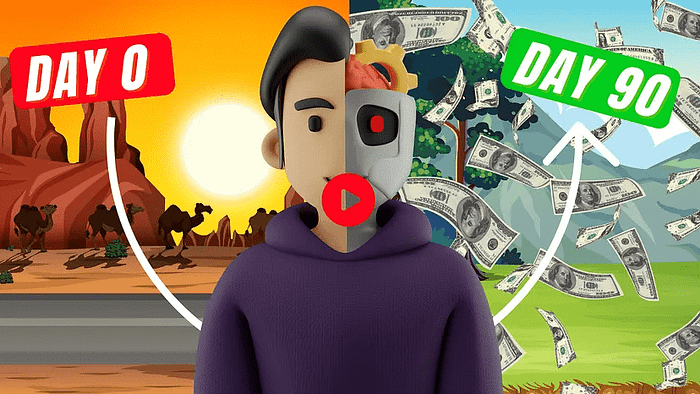As a blogger, one of your primary goals is to attract more visitors to your website. Search Engine Optimization (SEO) is a crucial aspect of achieving this goal, as it helps your blog rank higher in search engine results pages (SERPs), making it more visible to potential readers. In this article, we will discuss the 10 best SEO tips for bloggers to boost their traffic and improve their online presence. By implementing these strategies, you can optimize your blog for search engines and attract more organic traffic to your site.
We strongly recommend that you check out our guide on how to take advantage of AI in today’s passive income economy.
Table of Contents
1. Conduct Thorough Keyword Research
Keyword research is the foundation of any successful SEO strategy. By identifying the right keywords and phrases that your target audience is searching for, you can optimize your blog content accordingly. Start by brainstorming a list of relevant topics and using keyword research tools like Google Keyword Planner, SEMrush, or Ahrefs to find high-volume, low-competition keywords. Once you have a list of target keywords, incorporate them naturally into your blog posts, including the title, headings, meta description, and throughout the content.
When conducting keyword research, consider long-tail keywords, which are more specific and typically have lower competition. These keywords may have lower search volumes, but they often attract more targeted traffic and have higher conversion rates. Additionally, keep in mind the search intent behind the keywords you choose. Ask yourself what your target audience is looking for when they search for a particular keyword, and create content that satisfies their needs.
2. Optimize Your Blog’s Structure and Navigation
Your blog’s structure and navigation play a significant role in SEO. A well-organized site structure helps search engines understand your content and makes it easier for users to navigate your blog. Start by creating a clear hierarchy of categories and subcategories, and ensure that your blog posts are properly tagged and categorized. Use descriptive, keyword-rich URLs for your blog posts, as this helps search engines understand the content of each page.
Implement a user-friendly navigation menu that allows visitors to easily find the content they’re looking for. Include a search bar to help users quickly locate specific topics or posts. Ensure that your blog is mobile-friendly and responsive, as more and more people are accessing websites from their smartphones and tablets. A mobile-friendly design not only improves user experience but also positively impacts your SEO, as Google prioritizes mobile-friendly websites in its search results.
Focus on Internal Linking
Internal linking is the practice of linking to other relevant pages within your blog. This helps search engines understand the structure and hierarchy of your site, and it also helps distribute link equity throughout your blog. When creating new content, look for opportunities to link to your existing blog posts. Use descriptive anchor text that accurately reflects the content of the linked page, and avoid using generic phrases like “click here.”
In addition to helping with SEO, internal linking also improves user experience by providing visitors with additional relevant content. This can help reduce your blog’s bounce rate and increase the average time spent on your site, both of which are positive signals for search engines. To make the most of internal linking, create a content hub or pillar page that covers a broad topic and links to more specific, related blog posts.
3. Create High-Quality, Engaging Content
One of the most important SEO tips for bloggers is to create high-quality, engaging content. Search engines prioritize content that provides value to users and answers their questions or solves their problems. When planning your blog content, focus on topics that are relevant to your target audience and align with your blog’s niche. Use your keyword research to guide your content creation, but don’t sacrifice quality for the sake of keyword stuffing.
Write in a clear, concise, and engaging manner, using short paragraphs, subheadings, and bullet points to break up the text and make it easier to read. Use images, videos, and infographics to enhance your content and make it more visually appealing. Aim to create content that is informative, entertaining, and shareable, as this can help attract more backlinks and social media shares, both of which are important for SEO.
Optimize Your Blog Posts for Featured Snippets
Featured snippets are the short excerpts that appear at the top of Google’s search results, providing a quick answer to a user’s query. Optimizing your blog posts for featured snippets can help you attract more traffic and establish your blog as an authoritative source of information. To optimize for featured snippets, identify question-based keywords related to your topic and provide clear, concise answers within your content.
Use proper formatting, such as headings, lists, and tables, to structure your content in a way that makes it easy for search engines to understand and extract the relevant information. Additionally, ensure that your blog post comprehensively covers the topic, as Google tends to favor in-depth, high-quality content when selecting featured snippets.
4. Build High-Quality Backlinks
Backlinks are links from other websites that point to your blog. They are a crucial factor in SEO, as search engines view them as a vote of confidence in your content. The more high-quality backlinks you have, the higher your blog is likely to rank in search results. However, it’s important to focus on quality over quantity when it comes to backlinks.
To build high-quality backlinks, start by creating valuable, informative content that other websites will want to link to. Reach out to other bloggers and websites in your niche and offer to write guest posts or collaborate on content. Participate in online communities and forums related to your blog’s topic, and share your expertise by providing helpful answers and linking back to relevant blog posts.
Monitor Your Backlink Profile
In addition to actively building backlinks, it’s essential to monitor your backlink profile regularly. Use tools like Google Search Console, Ahrefs, or Moz to keep track of the websites linking to your blog. Look for any suspicious or low-quality links that could potentially harm your SEO, and take steps to have them removed or disavowed.
Keep an eye out for opportunities to reclaim lost backlinks, such as when a website removes a link to your blog or when a linking page is deleted. By monitoring your backlink profile and taking proactive steps to maintain a healthy link profile, you can improve your blog’s SEO and attract more organic traffic.
5. Optimize Your Images
Images play a crucial role in making your blog posts more engaging and visually appealing. However, they can also impact your blog’s SEO if not optimized properly. Start by compressing your images to reduce their file size without compromising quality. This helps improve your blog’s loading speed, which is a crucial factor in SEO and user experience.
Use descriptive, keyword-rich file names for your images, and include alt text that accurately describes the content of each image. Alt text helps search engines understand the context of your images and can also improve accessibility for visually impaired users. Additionally, consider creating an image sitemap to help search engines discover and index your images more effectively.
Leverage Image SEO to Drive Traffic
In addition to optimizing your images for SEO, you can also leverage them to drive more traffic to your blog. Create infographics, charts, and other visual content that is informative and shareable. Encourage other websites to use your images by providing an embed code and asking for a link back to your blog.
Use Pinterest and other image-based social media platforms to promote your blog’s visual content and attract more visitors. By creating high-quality, optimized images and leveraging them effectively, you can improve your blog’s SEO and attract more targeted traffic.
6. Improve Your Blog’s Loading Speed
Page loading speed is a crucial factor in SEO and user experience. Visitors are more likely to leave your blog if it takes too long to load, which can increase your bounce rate and negatively impact your search rankings. To improve your blog’s loading speed, start by optimizing your images, as discussed earlier.
Use a content delivery network (CDN) to distribute your blog’s content across multiple servers, reducing the distance between your visitors and your content. Minimize the use of plugins and external scripts, as these can slow down your blog’s loading time. Enable browser caching to allow repeat visitors to load your blog more quickly.
Monitor and Optimize Your Blog’s Performance
Regularly monitor your blog’s loading speed using tools like Google PageSpeed Insights, GTmetrix, or Pingdom. These tools provide detailed reports on your blog’s performance and offer suggestions for improvement. Implement the recommended optimizations, such as minifying your CSS and JavaScript files, enabling Gzip compression, and leveraging browser caching.
Continuously monitor your blog’s performance and make adjustments as needed to ensure that your site remains fast and responsive. By prioritizing page loading speed, you can improve your blog’s SEO, reduce bounce rates, and provide a better user experience for your visitors.
7. Engage with Your Audience
Engaging with your audience is not only essential for building a loyal reader base but also for improving your blog’s SEO. Encourage comments on your blog posts and respond to them promptly. This helps create a sense of community and encourages readers to return to your blog for future updates.
Leverage social media platforms to promote your blog content and engage with your followers. Share your blog posts on platforms like Facebook, Twitter, and LinkedIn, and participate in relevant discussions. Encourage your readers to share your content on their own social media profiles, as this can help attract more traffic and backlinks to your blog.
Implement Social Sharing Buttons and Encourage User-Generated Content
Make it easy for your readers to share your blog content by implementing social sharing buttons on your posts. Place the buttons in a prominent location, such as at the top or bottom of each post, to encourage sharing. Consider using a plugin or tool that allows you to customize the appearance of your social sharing buttons and track their performance.
Encourage user-generated content by asking your readers to submit their own stories, experiences, or opinions related to your blog’s topic. This not only helps create a sense of community but also provides you with fresh content ideas and can attract more traffic to your blog. Be sure to moderate user-generated content to ensure that it meets your blog’s quality standards and aligns with your brand’s values.
8. Utilize Schema Markup
Schema markup is a type of structured data that helps search engines better understand the content of your blog. By implementing schema markup, you can provide additional context about your blog posts, such as the author, publication date, and main topic. This can help your blog stand out in search results and potentially attract more clicks.
To implement schema markup, use a tool like Google’s Structured Data Markup Helper to generate the appropriate HTML code for your blog posts. Add this code to your blog’s template or manually insert it into each post. Be sure to test your schema markup using Google’s Structured Data Testing Tool to ensure that it is implemented correctly.
Take Advantage of Rich Snippets
In addition to helping search engines understand your content, schema markup can also enable rich snippets in search results. Rich snippets are enhanced search results that include additional information, such as star ratings, review counts, or pricing information. By implementing the appropriate schema markup for your blog’s content, you can potentially qualify for rich snippets and make your search listings more attractive to potential visitors.
To maximize your chances of earning rich snippets, focus on creating high-quality, informative content that aligns with the schema markup you’ve implemented. Monitor your search listings regularly to see if your rich snippets are appearing and make adjustments to your schema markup as needed.
9. Monitor Your SEO Performance
To ensure that your SEO efforts are paying off, it’s essential to regularly monitor your blog’s performance. Use tools like Google Analytics and Google Search Console to track your blog’s traffic, search rankings, and user behavior. Analyze your data to identify areas for improvement and adjust your SEO strategy accordingly.
Pay attention to metrics like organic traffic, bounce rate, average time on page, and pages per session. These metrics can provide valuable insights into how well your blog is performing and where you may need to focus your optimization efforts.
Conduct Regular SEO Audits
In addition to monitoring your blog’s performance, conduct regular SEO audits to identify any technical issues or opportunities for improvement. Use tools like Screaming Frog or SEMrush to crawl your blog and check for broken links, duplicate content, and other technical SEO issues.
Analyze your blog’s backlink profile, content quality, and keyword rankings to identify areas where you may need to focus your efforts. By conducting regular SEO audits and making data-driven decisions, you can continuously improve your blog’s search performance and attract more organic traffic.
10. Stay Up-to-Date with SEO Best Practices
SEO is an ever-evolving field, with search engines continually updating their algorithms and best practices. To ensure that your blog remains competitive in search results, it’s crucial to stay up-to-date with the latest SEO trends and techniques.
Follow industry blogs and publications, such as Search Engine Journal, Moz, and Search Engine Land, to stay informed about the latest SEO news and best practices. Attend webinars, conferences, and workshops to learn from industry experts and network with other bloggers and SEO professionals.
Adapt Your SEO Strategy as Needed
As search engines evolve and user behavior changes, it’s essential to adapt your SEO strategy accordingly. Be prepared to adjust your keyword targeting, content creation, and link-building tactics based on new insights and best practices.
Continuously test and refine your SEO approach, focusing on the tactics that deliver the best results for your blog. By staying agile and responsive to changes in the SEO landscape, you can maintain your blog’s search performance and continue to attract more organic traffic over time.
Conclusion
Implementing these 10 best SEO tips for bloggers can help you boost your blog’s traffic and improve your online presence. By focusing on keyword research, high-quality content creation, technical optimization, and staying up-to-date with SEO best practices, you can attract more organic traffic and establish your blog as an authoritative source in your niche.
Remember that SEO is an ongoing process, and it takes time and effort to see significant results. Stay patient, persistent, and committed to providing value to your audience, and your blog’s search performance will continue to improve over time.
FAQ:
How to do SEO for beginners?
As a beginner, you can start your SEO journey by following these steps:
- Conduct keyword research to identify relevant, high-volume, and low-competition keywords for your website.
- Optimize your website’s structure and navigation to make it search engine-friendly and user-friendly.
- Create high-quality, engaging content that targets your chosen keywords and provides value to your audience.
- Optimize your on-page elements, such as title tags, meta descriptions, headers, and images, using your target keywords.
- Build high-quality backlinks from reputable websites to improve your site’s authority and search rankings.
- Monitor your SEO performance using tools like Google Analytics and Google Search Console, and continuously refine your strategy based on the data.
How can I do SEO for my website?
To do SEO for your website, follow these steps:
- Conduct a thorough SEO audit of your website to identify areas for improvement.
- Optimize your website’s structure, navigation, and URL structure to make it search engine-friendly.
- Research and target relevant keywords for each page of your website.
- Create high-quality, keyword-optimized content that meets your audience’s needs and search intent.
- Optimize your on-page elements, such as title tags, meta descriptions, headers, and images.
- Build high-quality backlinks from authoritative websites in your niche.
- Improve your website’s loading speed and mobile-friendliness to enhance user experience and search performance.
- Monitor your SEO performance and adjust your strategy as needed.
How to use SEO for marketing?
To use SEO for marketing, follow these best practices:
- Align your SEO strategy with your overall marketing goals and target audience.
- Conduct keyword research to identify the terms and phrases your target audience is using to find products or services like yours.
- Create high-quality, informative, and engaging content that targets your chosen keywords and addresses your audience’s pain points and needs.
- Optimize your website’s structure, navigation, and on-page elements to improve its search engine visibility and user experience.
- Build high-quality backlinks from authoritative websites in your industry to improve your website’s credibility and search rankings.
- Leverage local SEO tactics, such as creating local business listings and optimizing for local keywords, to attract nearby customers.
- Integrate your SEO efforts with your other marketing channels, such as social media, email marketing, and paid advertising, to create a cohesive and effective marketing strategy.
How does SEO work?
SEO works by optimizing a website to improve its visibility and ranking in search engine results pages (SERPs) for relevant keywords. Here’s a basic overview of how SEO works:
- Search engines use crawlers or bots to scan and index web pages across the internet.
- When a user enters a search query, the search engine’s algorithm analyzes the indexed pages to determine the most relevant and authoritative results for that query.
- The algorithm considers various factors, such as the page’s content, structure, backlinks, and user engagement, to determine its relevance and authority.
- The search engine then displays the results in order of relevance and authority, with the most relevant and authoritative pages appearing at the top of the SERPs.
By optimizing a website’s content, structure, and backlinks for relevant keywords and user experience, SEO helps improve its visibility and ranking in the search results, attracting more organic traffic and potential customers.

We strongly recommend that you check out our guide on how to take advantage of AI in today’s passive income economy.




